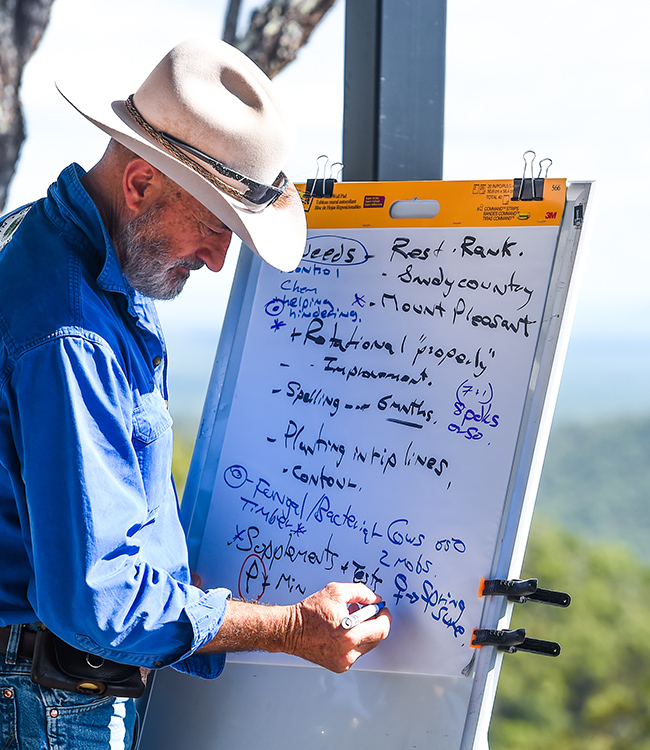Dick Richardson of Natures Equity in the paddock with workshop participants at Terry Creek Station near Collinsville.
Grazing Naturally roadshow in Eungella, Terry Creek
Grazing specialist Dick Richardson from Nature’s Equity begins his workshop in the “classroom” explaining the rationale behind the grazing methods he promotes.
Bowen and Eungella landholders recently heard grazing specialist, Dick Richardson, talk about improving soil health and pasture performance, one paddock at a time.
The aim of the workshops was to learn about the relationship between ecosystem function and patterns of grazing, with the Grazing Naturally method demonstrated as a viable solution to address ecological decline in changing climate and economic conditions.
Topics covered include:
- how plants, animals and living organisms build soil;
- the effects of light and heavy set stocking;
- building soil carbon and soil depth, using natural grazing patterns of animals;
- the basics of the Grazing Naturally method;
- matching stocking rate to carrying capacity;
- assessing feed availability using the STAC method; and
- a practical session on plant health and soil building in the paddock.
The Landholders Driving Change project hosted Dick Richardson workshops at properties near Bowen and Eungella.
Brett Scott, manager Flagstone Station asks a question.
Eungella graziers during smoko at the Dick Richardson grazing naturally workshop.
Dick Richardson, Nature’s Equity explains the cycling of nutrient during the growing season above and below ground.
Getting the balance right
The Grazing Naturally method is to graze a priority paddock repeatedly and intensely during the pasture-growing season, then spelling it for up to 12 months. The trick is to get the balance right, and every grazing operation is different.
As cold soils warm up, plants grow leaves with stored carbohydrates. The leaves produce food for the plant by using photosynthesis to grow more leaves, stems, roots and seeds.
Plant growth makes forage, and plants store excess food (e.g. carbohydrates and protein) to make next year’s forage. Depending on management strategies, grazing can slow or enhance plant growth.
Grazing can enhance plant growth by allowing growing leaves to gain access to sunlight or by recycling nutrients, but during the growing season, grazing removes leaves that were capturing energy.
Not grazing allows leaves to continue growing, producing forage up to a point. However, forage for animal production is of the highest quality while plants are green and growing.
Therein lies a principal challenge for grazing management. Using the different plant communities across a property, producers strive to have livestock graze green forage while it is at its most nutritious value for as long as possible, especially when livestock nutritional needs for production and reproduction are greatest.
To grow useful forage plants, producers manage the timing, duration, and intensity of grazing, and the timing and duration of recovery periods. Grazing management requires strategy and planning.
Eungella graziers gather round presenter Dick Richardson as they discuss the appropriate rest periods for paddocks in their area.
ALSO IN THIS ISSUE:






